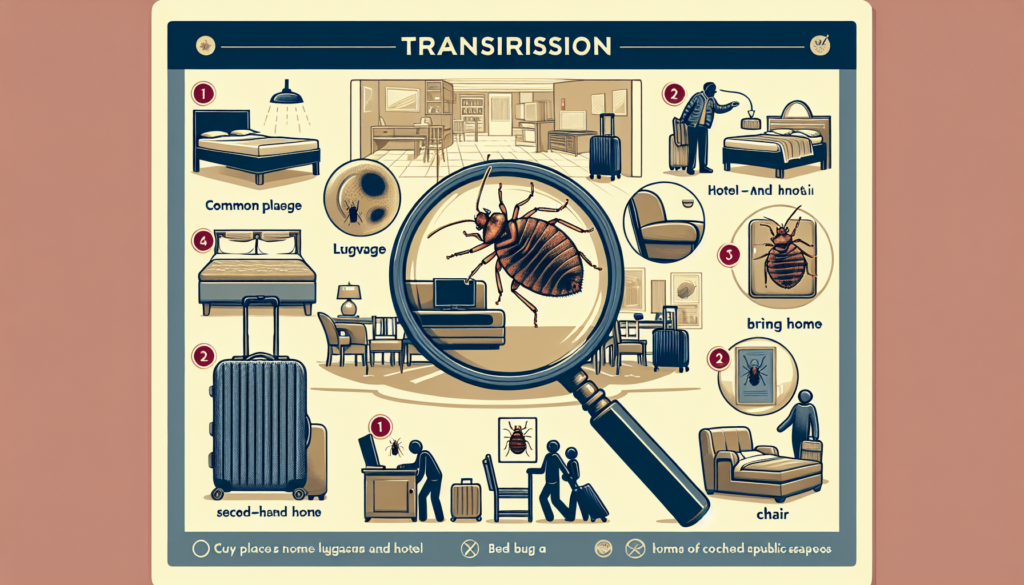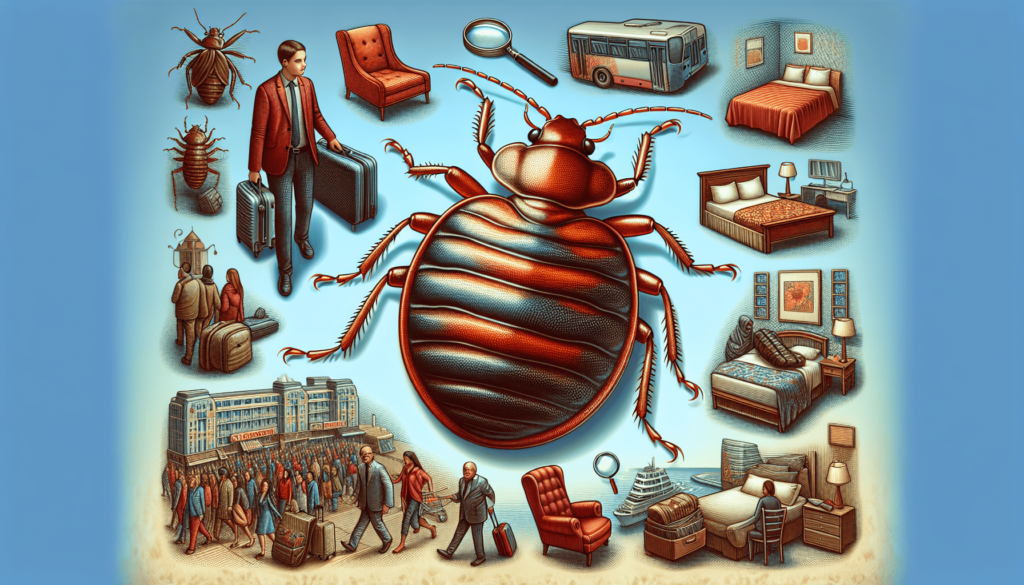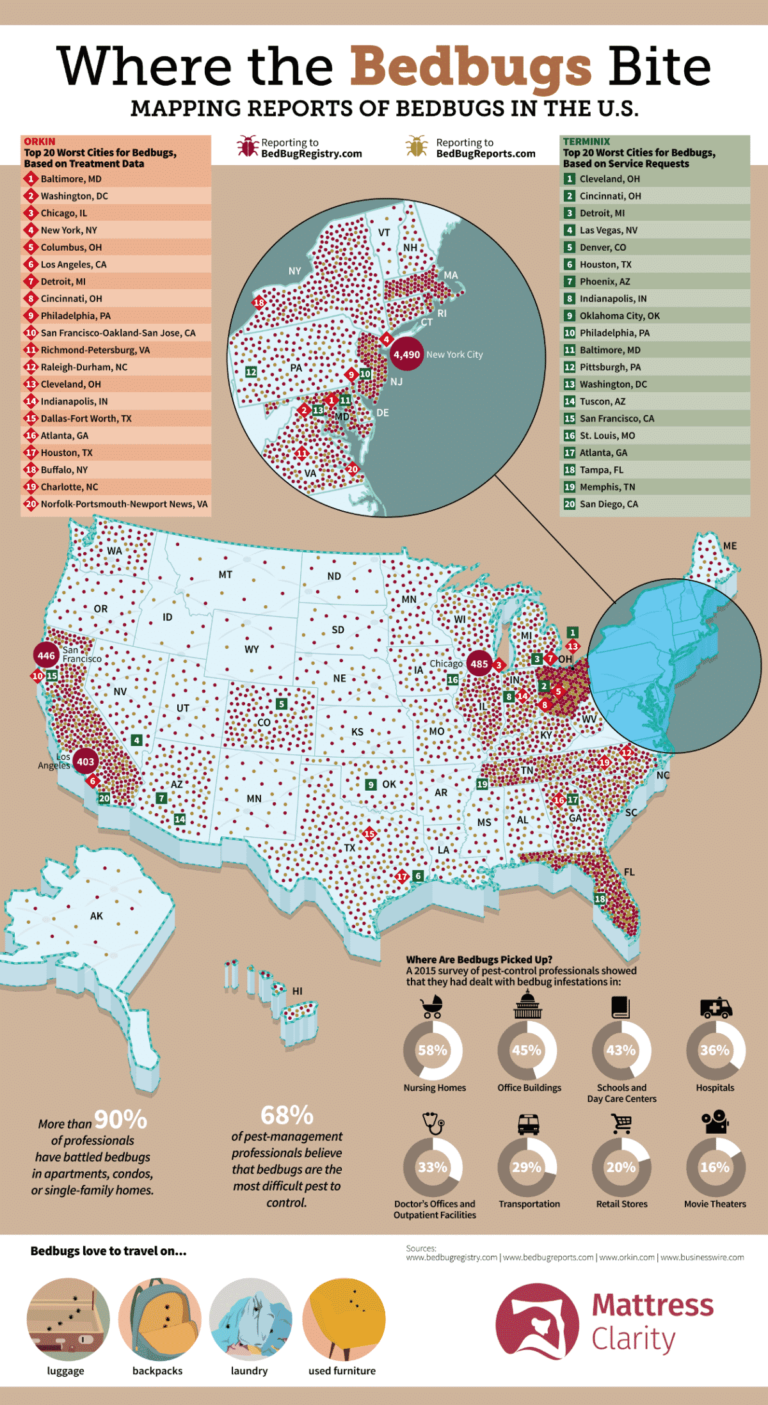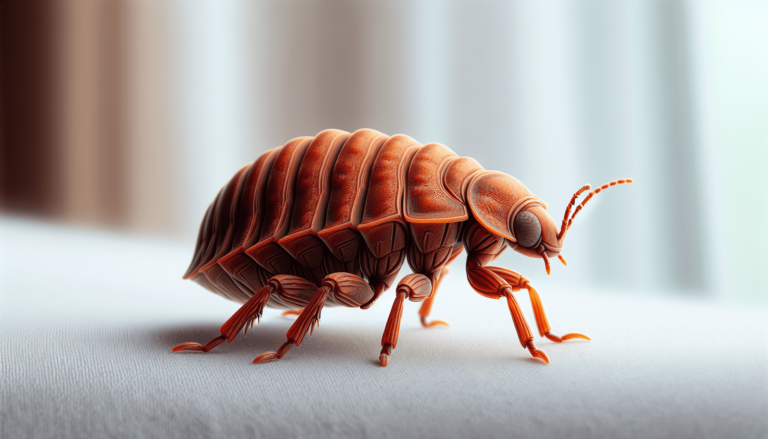How Are Bed Bugs Transmitted?
“How Are Bed Bugs Transmitted?”
Discovering a bed bug infestation in your home can be disconcerting. These tiny pests can quickly multiply and cause irritating bites as they feed on human blood. But how do bed bugs end up in your home in the first place? Understanding how bed bugs are transmitted is crucial in preventing and treating infestations. In this comprehensive article, you will delve into the various ways bed bugs can be introduced into your living space, from traveling to second-hand furniture. With a wealth of information, statistics, expert insights, and real-life examples, you will gain the knowledge to protect yourself and your home from these elusive pests. So, let’s dive into the world of bed bug transmission and arm ourselves with the necessary tools to combat them effectively.
Understanding the Nature of Bed Bugs
Bed bugs are small, oval-shaped insects that belong to the family Cimicidae. Despite their name, they are not limited to infesting beds. These pests are excellent hitchhikers and can be found in various places, such as furniture, luggage, and even on clothing. To effectively prevent and manage bed bug infestations, it is crucial to understand their distinguishing features, life cycle, feeding patterns, and habits.
Distinguishing features of bed bugs
Identification is essential when dealing with bed bugs. Adult bed bugs are approximately the size of an apple seed, ranging from 4 to 5 millimeters in length. They have flat bodies, six legs, and are reddish-brown in color. One of their distinguishing features is their unique scent, often described as a sweet, musty odor.
Life cycle and habits
Understanding the life cycle of bed bugs is key to combating infestations. Bed bugs go through multiple stages of development from eggs to nymphs and finally, adults. The duration of their life cycle varies depending on factors such as temperature and availability of food. However, under optimal conditions, bed bugs can mature and reproduce within a few months.
Bed bugs are nocturnal creatures, primarily active at night when their hosts are asleep. During daylight hours, they hide in cracks and crevices near their host’s resting area. Common hiding places include mattresses, bed frames, headboards, and furniture. They can also conceal themselves in electrical outlets, wallpaper, and behind baseboards.
Feeding patterns and habits
Bed bugs are obligate blood feeders, meaning they require blood to survive and reproduce. They can feed on any warm-blooded animal, although human blood is their preferred food source. Bed bugs use their elongated mouthparts to pierce the skin and extract blood from their hosts. The bites of bed bugs can cause itching, redness, and welts.
Contrary to popular belief, bed bugs are not attracted to dirt or filth. They can infest both clean and dirty environments, as long as there is a source of blood available. However, clutter and a high level of infestation can make it more challenging to control and eliminate these pests.
Common Misconceptions About Bed Bug Transmission
There are several misconceptions surrounding bed bugs and how they are transmitted. It is essential to debunk these myths to gain a better understanding of the pests and effectively manage infestations.
Myth: Bed bugs spread diseases
Unlike other blood-feeding insects, such as mosquitoes, bed bugs are not known to transmit diseases to humans. While their bites can cause discomfort and allergic reactions in some individuals, they do not pose significant health risks. However, it is important to note that excessive scratching of bed bug bites can lead to secondary infections.
Myth: Bed bugs only infest unclean environments
Bed bugs do not discriminate based on cleanliness. They are attracted to the warmth and carbon dioxide emitted by their hosts, rather than uncleanliness. Bed bugs can infest immaculate homes, hotels, and other establishments, as long as there is a source of blood available. Regular cleaning and good hygiene practices can help prevent infestations but are not foolproof measures.
Myth: Bed bugs can fly or jump
Unlike fleas or flies, bed bugs do not have wings or the ability to fly or jump. They are excellent climbers and can crawl quickly over various surfaces, including walls, ceilings, and furniture. Their climbing abilities, coupled with their propensity for hitchhiking, enable them to move from place to place with ease.

Bed Bug Mobility and How they Move from Place to Place
Understanding how bed bugs move is crucial for preventing and controlling infestations. While they cannot fly or jump, they have adaptations that allow them to disperse and infest new areas.
Speed of crawling bed bugs
Bed bugs have a crawling speed of approximately 4 feet per minute, making them relatively fast movers compared to other pests. This speed, coupled with their small size, allows them to navigate through cracks, crevices, and other tiny openings.
Ability to climb various surfaces
Bed bugs have specialized claws and leg structures that enable them to climb various surfaces. They can easily traverse rough materials such as fabric, wood, and even rough-textured walls. Their ability to climb vertically and horizontally allows them to access potential hosts and find new hiding places.
Physical limitations in movements
While bed bugs are agile climbers, they do have certain physical limitations. They are not able to jump or fly like other insects. Additionally, they cannot swim, and excessive moisture can hinder their mobility. These limitations make it important to consider effective prevention methods such as encasing mattresses, sealing cracks, and reducing clutter to restrict their movement.
Mechanisms of Bed Bug Transmission
Bed bugs have various methods of transmission, which contribute to their ability to spread and infest new areas. Understanding these mechanisms is vital in preventing the introduction and spread of these pests.
Attachment to clothes and luggage
One of the primary ways bed bugs are transported is through attachment to clothes and luggage. These pests can crawl onto clothing or hide in the folds of luggage, unknowingly accompanying individuals to new locations. It is essential to inspect and treat luggage after traveling to minimize the risk of introducing bed bugs into your home.
Infested furniture
Bed bugs can infest furniture, particularly upholstered items such as couches, chairs, and beds. Infested furniture provides a hiding place and a potential food source for bed bugs. When infested furniture is moved or shared, the bugs can easily transfer to new locations and create new infestations. Thoroughly inspecting used furniture before bringing it into your home is crucial to preventing infestations.
Spread through walls and pipes in multi-unit buildings
In multi-unit buildings, bed bugs can move from one unit to another through walls and pipes. They can crawl along electrical wires, plumbing, and heating ducts, exploiting even the tiniest cracks and gaps. This makes it essential for building management and tenants to address infestations promptly to prevent the spread of bed bugs throughout the entire structure.

Role of Travelling in Bed Bug Transmission
Traveling plays a significant role in the spread of bed bugs. Hotels, transient lodging, and public transportation systems act as hotspots for bed bug transmission. Vigilance during travel is essential to minimize the risk of bringing bed bugs back home.
Hotels and transient lodging as hotspots
Hotels and transient lodging establishments are often implicated in bed bug infestations. These pests can hitch a ride on luggage or clothing and infest hotel rooms, where they can easily transfer to new hosts. It is crucial to inspect hotel rooms for signs of bed bugs, such as bloodstains on sheets, dark spots (fecal matter), or the bugs themselves, before settling in.
Use public transportation systems
Bed bugs can also be found in public transportation systems, such as buses and trains, due to their ability to hitchhike. They can conceal themselves in seats, upholstery, or cracks within the vehicle. Taking precautions such as inspecting seats and avoiding placing luggage on the floor can help prevent bed bug transmission during travel.
Importance of travel vigilance
To prevent bed bug transmission during travel, it is essential to remain vigilant. Inspecting luggage before returning home, washing and drying clothes on high heat, and avoiding placing luggage on beds or upholstered furniture can minimize the risk of bringing bed bugs home. Promptly addressing any infestation discovered after travel is crucial to prevent further spread.
The Impact of Human Behavior on Transmission
Human behavior plays a significant role in bed bug transmission. Certain actions or habits can inadvertently contribute to infestations and make it challenging to control and eliminate bed bugs.
Reckless disposal of infested items
Improper disposal of infested items can lead to the spread of bed bugs. Individuals who discard infested furniture or other belongings without taking proper precautions may inadvertently introduce bed bugs to new areas. It is crucial to seal infested items securely in plastic bags before disposal to prevent the bugs from escaping and infesting other locations.
Frequent relocation and its effects
Frequent relocation can increase the risk of bed bug transmission. Individuals who move frequently or reside in temporary accommodations are more likely to encounter bed bugs or unknowingly transport them to new places. Taking preventive measures, such as inspecting new residences before moving in, can help minimize the risk of introducing bed bugs into new environments.
Neglect of early detection signs
Neglecting early detection signs of bed bugs can lead to more significant infestations. Individuals who ignore or dismiss signs such as small red welts on their skin or the presence of small reddish-brown bugs in their living spaces allow the infestation to worsen. Early detection is crucial for effective control and prevention of bed bug transmission.
Can Bed Bug Transmission Be Prevented?
While eliminating the risk of bed bug transmission entirely may not be possible, there are several preventive measures individuals can take to minimize infestations.
Routine checks and early detection
Regularly inspecting living spaces for signs of bed bugs and promptly addressing any infestations can prevent their spread. Familiarize yourself with the signs of bed bug infestations, such as blood stains, dark spots (fecal matter), shed skins, or the presence of live bugs. Early detection allows for timely intervention and prevents further transmission.
Proper handling and disposal of infested materials
If you encounter bed bugs in your home, it is essential to handle infested materials carefully. Seal infested items, such as clothing or bedding, in plastic bags before removing them from the infested area. Properly disposing of infested materials and preventing them from coming into contact with others can minimize the risk of transmission.
Professional pest control services
In cases of severe infestations or persistent bed bug problems, it is advisable to seek professional pest control services. Experienced pest control professionals can accurately identify the extent of infestation, develop effective treatment strategies, and provide guidance on prevention measures. Professional intervention can help ensure thorough eradication and prevent re-infestation.
Dealing with a Bed Bug Infestation
Discovering a bed bug infestation can be distressing, but there are steps you can take to address the issue effectively.
Initial measures to be taken
When faced with a bed bug infestation, it is important to act swiftly and systematically. Begin by isolating the infested area and reducing clutter to make treatment and inspection easier. Thoroughly vacuum infested areas, paying close attention to cracks, crevices, and seams, and dispose of the vacuum bag in a sealed plastic bag. Launder infested bedding and clothing on high heat to kill any bed bugs and their eggs.
Contacting a professional exterminator
While DIY methods can help alleviate minor infestations, professional assistance may be necessary for more severe cases. Contacting a licensed and experienced pest control professional ensures a comprehensive and effective treatment plan. Professionals have the training, knowledge, and tools to tackle bed bug infestations and prevent their recurrence.
Precautions to prevent future re-infestation
After successfully eliminating a bed bug infestation, taking preventive measures is crucial to avoid future re-infestations. Regularly inspect the premises for any signs of bed bugs, particularly in areas prone to infestations, such as beds, sofas, and other resting areas. Encasing mattresses and box springs with bed bug-proof covers and sealing cracks and crevices can help prevent the pests from returning.
How to Check for Bed Bugs While Traveling
When traveling, it is crucial to be proactive in checking for bed bugs to avoid bringing them back home with you.
Signs to look out for in lodging
When checking into a hotel or any other lodging, inspect the room thoroughly for signs of bed bugs. Look for bloodstains or dark spots on sheets, mattresses, and headboards. Check behind picture frames, along baseboards, and inside furniture drawers. If any signs of bed bugs are found, request a room change or consider finding alternative accommodations.
Proper handling of luggage
To prevent bed bugs from hitchhiking in your luggage, take precautions when handling your bags. Keep luggage off the floor and on a luggage rack or elevated surface. Avoid placing luggage on beds or upholstered furniture. After returning home, inspect your luggage outside or in an area with a hard surface, vacuum the luggage thoroughly, and launder clothing on high heat.
Steps if you encounter bed bugs during travel
If you discover bed bugs in your hotel room or encounter them during travel, it is crucial to take immediate action. Inform the hotel management or staff and request a room change to one that is not adjacent to the infested room. If changing rooms is not possible, consider finding alternative accommodations.
Socioeconomic Impact of Bed Bug Transmission
Bed bug infestations can have significant socioeconomic impacts on both individuals and communities. Understanding these impacts is crucial to address the social and economic consequences associated with bed bug transmission.
Cost of extermination and prevention
The cost of exterminating bed bugs can be substantial, particularly in cases of severe infestations or multi-unit buildings. Professional pest control services, treatment products, and the replacement of infested items can be expensive. Additionally, preventive measures, such as regular inspections and the use of protective encasements, incur ongoing costs.
Stigma associated with infestation
The presence of bed bugs can carry a stigma, leading to embarrassment, social isolation, and discrimination. Individuals may face judgment or negative perceptions from others, impacting their mental well-being and quality of life. Educational efforts and increased awareness can help reduce the stigma associated with bed bug infestations.
Psychological effects on infested households
Living with a bed bug infestation can have significant psychological effects on individuals and households. The fear and anxiety associated with the presence of bed bugs can cause sleep disturbances, stress, and a decline in mental health. Prompt intervention, counseling, and support services can help address the psychological impacts of bed bug infestations.
In conclusion, understanding the nature of bed bugs, debunking common misconceptions, and recognizing their mobility and mechanisms of transmission are essential for effective prevention and management. By adopting proactive measures, seeking professional assistance when needed, and being vigilant during travel, individuals can minimize the risk of introducing and spreading bed bugs. Addressing the socioeconomic impacts of bed bug transmission through education, support services, and effective pest management strategies is crucial to protect individuals, communities, and society as a whole.






